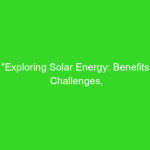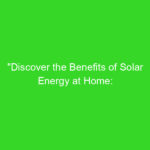
Compare Passive and Active Solar Energy
Solar energy is the most renewable source of energy that is available in abundance. It is harnessed using two different methods, namely active and passive solar energy. Both of these methods have their own unique advantages and disadvantages that make them suitable for different applications. In this article, we will explore the differences between passive and active solar energy.
Passive Solar Energy
Passive solar energy is the method of harnessing the energy from the sun without the use of mechanical or electrical devices. Instead, the design of the building or structure is such that it utilizes natural mechanisms to capture and store solar energy. The most commonly used passive solar energy techniques include the use of large windows, thermal mass, and insulation.
Advantages of Passive Solar Energy
-
Cost-Effective: Passive solar energy systems are relatively inexpensive to install, as they do not require the use of mechanical or electrical devices.
-
Low Maintenance: Passive solar energy systems have few moving parts, which makes them easier to maintain.
-
Sustainability: Passive solar energy systems have a long lifespan and generate no harmful emissions.
Disadvantages of Passive Solar Energy
-
Limited Efficiency: Passive solar energy systems are not as efficient as active solar energy systems.
-
Climate-Dependent: Passive solar energy systems are dependent on the climate and cannot be used in areas that do not receive enough sunlight.
-
Limited Control: Passive solar energy systems do not have a mechanism to control the amount of energy generated.
Active Solar Energy
Active solar energy is the method of harnessing the energy from the sun using mechanical and electrical devices such as solar panels, pumps, and controllers. The primary aim of active solar systems is to convert solar energy into electricity or heat to be used for various applications.
Advantages of Active Solar Energy
-
High Efficiency: Active solar energy systems are much more efficient than passive solar energy systems, as they can convert up to 80% of solar energy into usable power.
-
Versatility: Active solar energy systems can be used in a variety of applications, including homes, businesses, and industries.
-
Control: Active solar energy systems have a mechanism to control the amount of energy generated.
Disadvantages of Active Solar Energy
-
High Initial Cost: Active solar energy systems are relatively expensive to install, as they require mechanical and electrical devices.
-
Maintenance: Active solar energy systems have more moving parts, which makes them more difficult to maintain.
-
Sustainability: Active solar energy systems generate some waste and require proper disposal.
Conclusion
Both passive and active solar energy systems have their own unique advantages and disadvantages. Passive solar energy systems are cost-effective, low maintenance, and sustainable, but they are limited in efficiency and control. Active solar energy systems are highly efficient, versatile, and controllable, but they have a high initial cost and require more maintenance. Ultimately, the choice between passive and active solar energy depends on the specific needs of the application.





